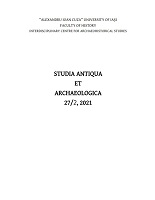Understanding technological innovations through experiment: Construction and testing of Chalcolithic pottery kilns
Understanding technological innovations through experiment: Construction and testing of Chalcolithic pottery kilns
Author(s): Felix-Adrian Tencariu, Radu Brunchi, Stanislav Țerna, Ana Drob, Maria-Cristina Ciobanu, Andreea Vornicu-Țerna, Casandra Brașoveanu, Denisa AdumitroaieiSubject(s): Anthropology, Archaeology, Visual Arts, Regional Geography, Ancient World, Prehistory
Published by: Editura Universităţii »Alexandru Ioan Cuza« din Iaşi
Keywords: Experimental archaeology; Cucuteni-Trypillia culture; Chalcolithic pottery kiln; technological innovation;
Summary/Abstract: Besides its contribution to understanding the formation process of large settlements and complex social organization in the late period of Cucuteni-Trypillia, the site of Stolniceni (Republic of Moldova) provided new data on the construction and spatial distribution within the site of pottery kilns. The extensive magnetic surveys revealed a large settlement, with more than 350 burnt dwellings, hundreds of pits, ditches, paths, and 19 kilns. Of the latter, four were excavated during the 2016-2018 campaigns. Three kilns were more or less similar in terms of sizes and construction, belonging to the “simple”, dual chambered, up draught type. The best-preserved of them already served as model for a published experiment conducted in 2017 near the Stolniceni archaeological base. The fourth provided several surprising building features, like six additional holes arranged around the fire channels and communicating with them, and two small clay arches above the channels’ ends. A plausible hypothesis of the researchers is that these elements were meant to improve the draught, by increasing and uniformizing the circulation of hot air throughout the upper chamber. Thus, in order to test how this technological innovation acts on the firing efficiency, we conducted a new experiment (August-September 2020, Băiceni-Romania). The firing process and temperatures reached in this type of kiln proved the concern of prehistoric potters for continuous improvement of their craft, raising questions about the emergence and socio-economic implications of such innovations.
Journal: Studia Antiqua et Archaeologica
- Issue Year: 27/2021
- Issue No: 2
- Page Range: 387-401
- Page Count: 15
- Language: English

